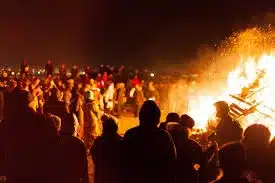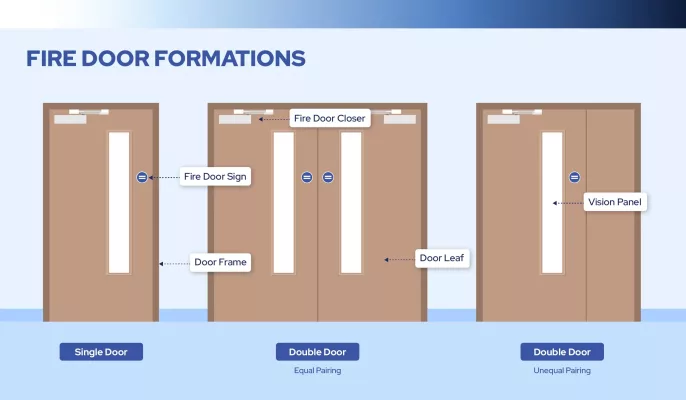Every year, as Bonfire Night approaches, fire services across the UK report a noticeable rise in fire-related incidents—particularly around homes, residential streets, and community celebration areas. What is traditionally an evening of fireworks, warmth, and gathering can quickly turn dangerous when safe handling and preparation are overlooked. This year, Northumberland Fire & Rescue Service has issued a renewed public safety reminder: fireworks and bonfires should be treated as controlled fire sources, not casual entertainment. The message is clear—celebration is welcome, but caution is essential to keep families, pets, neighbours, and entire communities safe.

Why Bonfire Night Requires Extra Fire Awareness
Bonfire Night, held each year on 5 November, is deeply rooted in British cultural tradition. Families gather in gardens, towns host firework displays, and communities celebrate with sparklers, bonfires, and seasonal food. It is a night associated with warmth and celebration — but also one that involves open flames and pyrotechnics in close proximity to homes and residential areas.
This is exactly why Northumberland Fire & Rescue Service has issued a clear reminder ahead of this year’s events. Fireworks should be purchased only from licensed sellers and used strictly within designated times. Bonfires should be placed well away from trees, fences, sheds, and property walls. Most importantly, as the service emphasised, fireworks are not toys but potential explosive materials and should be handled with the same level of caution as any controlled ignition source.
The message is practical rather than alarmist: enjoy the celebration, but do so with awareness of how quickly a spark can become a blaze—especially in tightly built residential neighbourhoods where one small fire can spread beyond the property where it began.

Key Fire Safety Tips for Households During Bonfire Night
For many people, the preparations for Bonfire Night begin days in advance — checking the weather, choosing fireworks, inviting friends or neighbours. Yet the small safety steps are the ones most commonly overlooked. They are simple, almost ordinary actions, but they are exactly what prevent an evening of celebration from turning into an emergency call.
1. Buy Fireworks from Licensed and Traceable Sellers
I’ve heard more than one neighbour say, “They’re all the same anyway.” They aren’t. Fireworks bought from unregulated sellers may lack consistent ignition control or may burn hotter and faster than expected. Licensed products come with instructions tested for UK conditions — that matters when sparks fall near sheds, fences, and dry grass.

2. Choose Your Lighting Spot Carefully
A residential garden can feel spacious, right up until the flame catches a low tree branch or a fence panel. Fire crews repeatedly mention that many Bonfire Night fires start in these borderline spaces — where celebration meets the side of the house. A few extra steps back from the wall can make a real difference.
3. Keep Water — and Calm — Close By
Most households remember the bucket of water. Fewer remember to keep everyone calm if something misfires. Panic is the true accelerant in many fire incidents. Knowing who will act if something goes wrong is just as important as the bucket itself.
4. Think About Pets, Windows, and Escape Paths
Dogs cower under tables, cats hide behind appliances. People close doors to keep them in — and unintentionally reduce escape routes. During Bonfire Night, homes tend to have more movement, more noise, and more potential for confusion. Making sure doors open freely and hallways remain clear is part of UK fire safety, even if no flame ever touches the property.
5. Fully Extinguish the Bonfire Before Leaving It
This is the point fire services stress every year: fires do not go out because people walk away. They go out because they are put out.
Dousing, stirring, and then dousing again is not overcautious — it is responsible.
Where Fire Doors Quietly Matter
No one sees a fire door during Bonfire Night. It doesn’t take part in the celebration.
But if a misjudged spark lands on a shed, or dry leaves in a shared courtyard ignite, or a neighbour’s firework falls sideways into a building entrance, the fire door becomes the difference between a scare and a tragedy.
Fire doors do not prevent joy.
They prevent the spread of heat, smoke, and panic — the real threats to life during residential fire incidents.
In shared housing blocks, terraced homes, converted flats, or any community residence with close-built structures, these silent barriers are sometimes the only thing standing between a single small fire and an entire building evacuation.
They are not dramatic. They are simply necessary.
The Hidden Risk — How Residential Layouts Influence Fire Spread
Bonfire Night fires rarely start inside the home. They begin outside — in gardens, on balconies, near shared entrances, or in the narrow strips of space between terraces where wood piles, bicycles, bins, or garden furniture naturally gather. These are the spaces no one thinks about when planning a celebration, yet they are often the exact point where a small flame becomes a structural fire.
In many modern UK developments — particularly apartment blocks and terraced housing — the boundaries between one household and the next are close and porous. A fire in a garden shed is not a private incident; the heat transfers across fencing, the smoke pools under eaves, and in some cases, flames can reach shared stairwells or external doorways long before anyone realises the situation has escalated.
Northumberland Fire & Rescue Service’s reminder this year subtly reflects this: the risk is not simply “someone mishandling fireworks,” but the fact that a small outdoor fire can quickly become a building fire in densely built communities.
And this is where a quiet, often unnoticed element of building safety makes its difference — the fire door.
Why Fire Doors Matter in Residential Fire Spread
A fire door is not designed to stop a fire from starting. It is designed to prevent it from moving — from a corridor to a staircase, from one flat into another, from a storage space into a living area. It slows the fire down — sometimes by 30 minutes, sometimes by an hour or longer.
In real time, that is long enough for families to leave safely, for neighbours to be alerted, and for fire crews to arrive before the structure is lost.
This is not speculation — it is documented reality:
| Fire ScenarioWithout Fire DoorWith Certified Fire Door | ||
|---|---|---|
| Average time for smoke to fill escape routes | 2–3 minutes in older buildings | 15–60 minutes depending on rating |
| Fire spread from external ignition point to interior hallway | Often under 8 minutes | Contained long enough for evacuation and response |
| Mortality rate in multi-residential night-time fires | Significantly higher where compartmentation fails | Reduced where fire doors remain properly closed and intact |
(Data references: UK Home Office Fire Statistics & BRE UK Fire Safety Research, compiled from residential fire case patterns.)
These numbers are not dramatic — but the gap between 3 minutes and 60 minutes is the gap between chaos and coordinated escape.
A Personal Detail That Often Goes Unmentioned
During Bonfire Night, people open and close doors more than usual.
Guests step into gardens. Children go in and out. Neighbours stop by.
And in that movement, internal fire doors — the ones that are meant to stay closed — can quietly be propped open.
A door hooked open with a shoe or bag looks harmless.
But if a fire breaks out, that small, forgettable detail becomes the reason smoke reaches a staircase or hallway before anyone has time to react.
On a night when fire, celebration, and movement coexist, the smallest architectural habits matter.
A closed fire door is not a precaution — it is time, and time is safety.
In many UK communities — especially in converted townhouses, social housing estates, and newly built apartment complexes — the shared entrance hall is where different households overlap. It is the space everyone walks through daily, but few people ever think of in terms of UK fire safety. On an ordinary evening, that doesn’t feel significant. On Bonfire Night, it can become crucial.
During celebrations, people gather outside to watch fireworks. Someone’s garden fire pit burns slightly longer than planned. A spark lands in a bin left just a bit too close to a doorway. A fire starts not inside a home, but just outside it — close enough to the building that smoke begins to move inward.
When smoke enters a shared hallway, the danger is no longer private.
It becomes a community incident, one where the actions of one household can affect everyone living beyond the same front door.
Residents who have lived through neighbourhood fire callouts often describe the same sensation: not flames, but smoke moving quickly and silently, filling corridors in seconds. People wake up not to heat, but to confusion — doors open, alarms sounding in the dark, neighbours calling out names.
In those moments, safety depends less on individual caution and more on how the building itself is structured to slow the fire down.
This is why the presence — and condition — of fire doors in shared entrance halls matters at a scale larger than any single household.
A properly fitted FD30 or FD60 door at the main entrance does not just protect one family; it protects everyone who uses that exit to escape.
Without it, smoke spreads from one front step into many front rooms.
With it, the fire is held long enough for the fire brigade to arrive and for residents to leave calmly instead of running.
| Building Type | % of Fire-Related Injuries Linked to Smoke Spread (Not Flame) | Primary Cause of Spread |
|---|---|---|
| Purpose-built flats | 64% | Failed or propped-open fire doors |
| Converted houses (now multiple flats) | 71% | Shared hallway smoke movement |
| Terraced housing with shared fencing | 48% | External ignition spreading inside |
Source: Home Office Incident Reporting System, combined multi-residential fire case analysis (UK 2021–2024)
This data consistently shows one quiet truth:
Smoke — not flames — is what turns a small fire into a community emergency.
And smoke spreads when barriers are missing, damaged, or left open.
A Simple Observation to Close This Section
Bonfire Night is not the problem.
Gathering isn’t the problem.
The tradition is not the problem.
The risk appears only when the physical barriers designed to protect residents are taken for granted — the shared stairwell door that no longer closes properly, the block entrance door with worn hinges, the internal fire door held open because it “just bangs otherwise”.
These are small everyday details — until the night when they aren’t.
Conclusion — Celebrating Together, Safeguarding Together
Bonfire Night remains one of the most recognisable and cherished cultural traditions in the UK. The glow of a garden fire, the sound of distant fireworks, the way neighbours gather outside in the cold — these are moments that knit communities together year after year. But as Northumberland Fire & Rescue Service has reminded us, celebration carries responsibility.
The difference between a safe evening and a dangerous one often comes down to small, quiet decisions: where the bonfire is placed, whether a firework is bought from a licensed seller, whether communal doors are kept closed, whether escape routes remain clear.
These are not dramatic acts of vigilance; they are gestures of consideration — for ourselves, for our families, and for those who live on the other side of the wall.
Bonfire Night belongs to everyone. So does the responsibility to keep it safe.


